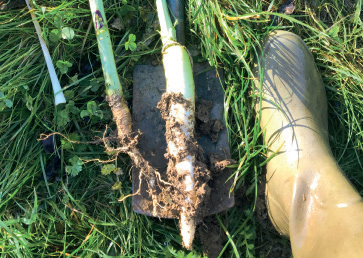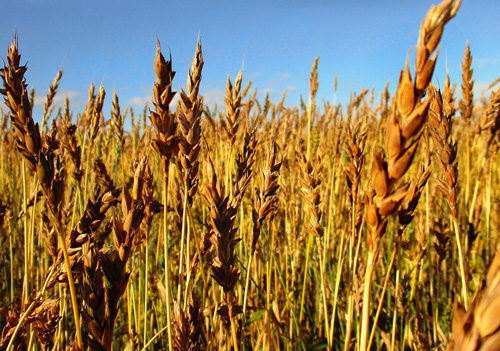- Soil Association
- Farmers & growers
- Low-input farming advice
- Cover crops and green manures
- Cover crops for organic arable

Cover crops for organic arable
There is a wide and often confusing choice of cover crops. Sam Lane looks at the options available to the organic farmer.
Sam Lane is Technical Manager at Cotswold Seeds
For organic producers, the health of their soil underpins the entire organic farming system. The producer knows that as much effort must be applied to protecting and building soil fertility, as to practicing good crop husbandry. Cover crops are a tool we can use to maintain, and hopefully, improve our soil health, along with other inputs, such as manure and compost. Deciding which cover crop species to use, how these species fit into a farming system and being aware of the pitfalls is important for success.
Five popular options
The key consideration is to identify the issues you are trying to resolve through the use of cover crops. Pinpointing problems, like runoff, poor soil structure, low soil fertility or weed issues will help to narrow down what can sometimes be a confusing choice of species.
Below are five popular cover crop species with a brief insight into their attributes and how they might improve an organic system.
Fodder radish
Fodder radish is a deep rooter, commonly known as fodder or oil radish. This is a member of the brassica family. It’s a small seeded, annual species that is easy to establish through both broadcasting or shallow drilling. The main benefits of radish are its reliability, speed of establishment and strong rooting. It can be used for improving soil structure and water infiltration, especially on heavier soils. Cousin to the fodder radish is the tillage radish. This plant produces a large parsnip-like tuber that sits partly above the ground, further helping to open up the soil.

The picture shows the difference between radish
(left) and deeper rooting tillage radish (right).
Vetch
Vetch, often known by the old fashioned term ‘tares’, is a good all rounder, smothering weeds and providing a range of soil benefits. As a legume, it can improve soil fertility by fixing atmospheric nitrogen, however, soils must be warm, at a reliable 7oC or more. Nodulation can begin within six to seven weeks of sowing under favourable conditions. The presence of pink-coloured round nodules on plant roots will indicate good nitrogen fixation. The sprawling growth habit of vetch, which uses long tendrils to climb up existing vegetation or cover the ground, make it a very effective crop at smothering weeds and covering bare ground. Many varieties of vetch are also winter hardy, so when sown in the autumn they ensure the ground is kept covered over the winter months.

Vetch (Vicia sativa) is effective for smothering weeds and covering bare ground
Annual clovers
Annual clovers boost fertility. When sown in warm spring conditions, annual clovers can be a useful way of giving the soil a short, sharp fertility boost before being terminated in eight to twelve weeks later (post flowering). It’s estimated that these species fix 40-75 kg N/acre, however this is dependent on plant growth stage, seasonality and weather conditions. Persian clover grows reliably in the UK and can reach flowering in 8-10 weeks from sowing. Normally, it does not survive winter frosts and during flowering it has a particularly fragrant scent. Crimson clover takes about three weeks longer to reach flowering than Persian clover. In the southern regions of the UK it can survive milder winters, providing winter sheep keep. For a winter hardy option, the lesser known Balansa clover can be used. This should survive winter conditions, but should not be planted too late in the autumn to ensure successful establishment.

Crimson clover (Trifolium incarnatum)
Winter rye
Winter rye (not to be confused with ryegrass) is a tried and tested cover crop species for reliable winter cover and is one of the best for scavenging and holding nutrients within the soil profile. This species is a true winter-hardy plant, remaining green throughout the winter. As a large cereal seed, it holds more reserves and is less reliant on soil temperature for germination, which means that it can be sown later in the autumn. Rye is one of the earliest to grow as winter moves into spring, so it can create a useful ‘early bite’ for livestock grazing, or it could be left in the ground until it starts to bulk up in May for a silage cut. As a cereal seed, careful consideration must be given to the sowing rate. Where weed smothering is the aim, a robust sowing rate should be used.

Winter rye
Short-term perennials
Short-term perennials for longer term fertility building. For a longer period of soil improvement there are species which will survive for more than a year, if space in the rotation allows. Red clover, chicory and sweet clover will all last for a two to three-year period and as perennial species, they can be repeatedly mowed, mulched or grazed. The benefit of leaving land longer in a fertility-building phase is better root development below the ground and the ability to add organic matter through mulching above the ground. In an organic system, both chicory and sweet clover can come back as volunteer plants if the parent plant is allowed to set seed. To avoid this, ensure the area is topped after flowering but before setting seed. The deep-rooted chicory will also need some inversion tillage to successfully terminate the plant and avoid regrowth in a subsequent crop.

Chicory (Cichorium intybus)
While growing cover crop species in isolation can definitely help to improve soil health, combining different species as a mixture can help to tick off more attributes on the cover crop ‘wish list’. For example, combining deep-rooting radish with shallower rooting crimson clover can create deeper subsoil root penetration, along with shallower fibrous roots to condition the topsoil and make it easier to work. Similarly, mixing species like rye and vetch helps to harness the robust and winter hardy nature of the rye, with the sprawling growth habit of the vetch, ensuring bare soil is left to a minimum and weeds are smothered.
With the huge variability in weather patterns as we’ve seen in 2020, combining a range of species in a cover crop mixture, rather than relying on a single species, can both harness a wider range of benefits and reduce the chance of a sowing failure.
The key question around cover crops is “What am I trying to achieve?” Always work forwards from there.
First published in Organic Farming Magazine, Winter 2021
Find out more
Cotswold Seeds supply organic seeds and have lots of helpful information, advice and resources.
